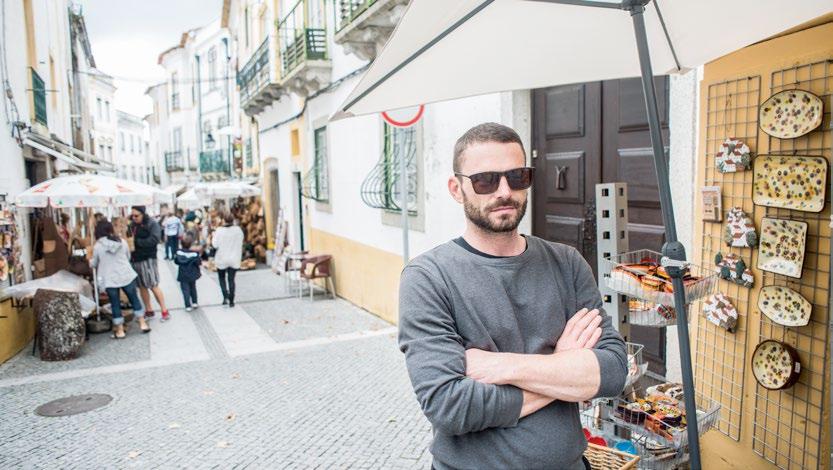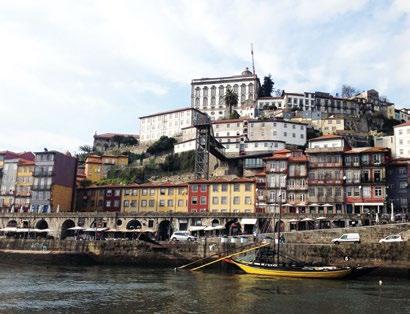
10 minute read
Voyage Voyage
Voyage
Welcome to KALTBLUT´s new rubric “Voyage, Voyage“. From now on, we will take you with us on trips around the world. Let’s start with one of the most beautiful countries in the world: Portugal. For a few years I have been traveling to Portugal for ModaLisboa, the fashion event in the South of Europe. Every time I’m there I go on a little trip through the country. And I lost my heart in Portugal. What I like the most about Portugal is the rich history. I mean, what would the world be without the brave men of Portugal who travelled around the world, 4-5 hundred years ago? Let´s face it, Europe would look different nowadays without these people. Portugal has been named many times as the poorest region of Europe, and yes, maybe there is some truth in it, but for me Portugal is just pure magic. The nature wows me everytime. The beach and the coast, the mountains. The food. Art and fashion. But most of all, Portugal is rich of the most lovable people with a big heart. The people there are proud, strong, sexy and always with a big smile on their face! Portugal is a forgotten kingdom. And now, where Autumn has just arrived here in Europe, you should book a trip to places like Lisbon, Porto or the Alentejo Region.
History Portugal became its own kingdom in 1139 but was not officially recognized until 1143. The border with Spain has been almost the same since the 13th century. Fishing and trade with other countries are important here. Portugal was important in world exploration for two reasons. Henry the Navigator, a prince from Portugal, was very interested in exploration. Inventions in navigation led to a bigger knowledge of geography. This world exploration began the Portuguese Empire. Portugal was a world power during the 15th and 16th centuries. However, it lost a lot of money soon after this. The city of Lisbon was destroyed in an earthquake in 1755. The country was occupied during the Napoleonic Wars. It lost its largest colony, Brazil, in 1822. In 1910, Portugal became a Republic, and in 1926, a military group took control of the country from the Portuguese 1st Republic. This began a time of rule by fascist governments that 52
lasted until 1974. That year, a peaceful left-wing army coup, called the Carnation Revolution, happened. The coup changed how the country was run. Portugal went into the European Union in 1986. The capital and largest city is Lisbon.

Lisbon Lisbon is the hub of a multifaceted area that appeals to different tastes and senses. In a city that has been influenced by many different far-off cultures over time, there is still a village feel in each historic neighbourhood. Stroll through the Pombaline grid of streets in the Baixa district that opens on to the Tagus in Praça do Comércio, then follow the river to discover some of the city’s most beautiful parts: the monumental area of Belém with its World Heritage monuments, the mediaeval quarters and the latest contemporary leisure spaces, such as the Parque das Nações. If you continue to the mouth of the river, you’ll understand why they say that Lisbon is the centre of a vast resort. Along the coastal road you’ll find beaches and beach resorts that combine villas and hotels from the beginning of the 20th century with marinas, terraces and excellent golf courses. Further along the coast you’ll come across world-renowned surfing
Voyage
beaches, but also the palaces scattered across the cultural landscape of Sintra, a World Heritage Site. The wide variety of landscapes and heritage is always close by, whether to the north or south of the capital. With beaches, natural parks, cultural routes and accommodation for all tastes, it is hard to escape the Lisbon region on a visit to Portugal.
Porto and the North It was in the Porto and in the North regions that Portugal was founded in the 12th century and the Portuguese became a people and a nation. Porto, a World Heritage city, is the gateway and departure point for a journey across the natural and cultural diversity of the region. It is known for the Port wine which is shipped from here all over the world, but also for a heritage which combines ancient churches and monuments, such as the Cathedral and the Church of São Francisco, and modern buildings, such as Casa da Música and the Serralves Museum. And also for its School of Architecture which bred

Favorite spots in Lisbon 1. A Vida Portuguese Store. An amazing store with vintage and 1950´s Portugues products. An eclectic store that holds only Portuguese brands and products for the home; from hand-made olive oil soaps to home decor, shoes, pantry, pastry, vintage posters. 2. São Pedro de Alcantara Terrace. At this spot you have the most amazing view over Lisbon. Sit down, have a coffee and just enjoy Portugal pure.
Favorite spots in Porto



1. One of the must-see buildings is the Casa da Música concert hall built by Dutch architect Rem Koolhaas with Office for Metropolitan Architecture as part of Porto’s project for the European Capital of Culture in 2001, and functions as Porto’s landmark since finished four years late in 2005 and with costs of 100 Million Euros well spent. 2. The Lello Library best known for being the interior inspiration for the Harry Potter movies. This is a must go place for all book lovers.
names like Álvaro Siza Vieira and Eduardo Souto de Moura, both winners of the Pritzker Prize. The region is crossed by the River Douro which enters Portugal between the ravines and mountains of the interior to flow through the entire World Heritage landscape where the Port and Douro wines are produced. It is from here that the wine is sent to the lodges at Vila Nova de Gaia, as the cruises touring the region make their way upriver. In this area of mountains and natural parks, the region’s heritage is seen in its castles, such as the one in Guimarães, and the shrines and churches which are the stage for pilgrimages in the summer. You will find the Baroque architecture of Northern Portugal in its stone and gilded carvings side by side with rural chapels. In its cities, which retain a human scale, such as Viana do Castelo, Braga, Lamego, Chaves and Vila Real, and in the manor houses and stately halls, you will find the genuine Portuguese people, who like to share their table, their customs and traditions.
Alentejo Region The vastness of the landscape is dotted with cork oaks and olive trees that withstand time. Santarém is a natural viewpoint over the immensity of the Tagus. Here and there, you find a walled town, such as Marvão or Monsaraz, or an ancient dolmen to recall the magic of the place. Around the hills, low, whitewashed houses stand on small knolls, castles evoke battles and conquests and the yards and gardens are witness to the Arab influences which shaped the people and nature. In the Alentejo the power of the land marks the time and cities like Elvas and Évora, listed as World Heritage by UNESCO, show the tenacity of the people. Perhaps this is the reason that culture and spirituality take on a singular character here. These memories of the past are also shared by other cities, such as Santarém, Portalegre and Beja, and in the former Jewish quarters, particularly in Castelo de Vide. The flat land makes hiking and cycling easy, though horses are also part of the landscape. You can combine these rides with birdwatching and, in dams such as Alqueva, with the tranquillity of the waters or stargazing. But you must also explore the coast. The landscape here is hilly and rugged, with small sheltered coves between
Voyage
the cliffs, many of which are ideal for surfing. You will also breathe the scents of the countryside here, the aromatic herbs that season the fish, seafood and other regional fare to be accompanied by the region’s excellent wines.

Food I lost my heart in Portugal, and not only because of the warm welcome from the people there, the food is just amazing. If you ever go to Portugal, you need to eat fish or one of the typical sweets. Portugal is a seafaring nation with a well-developed fishing industry and this is reflected in the amount of fish and seafood eaten. The country has Europe’s highest fish consumption per capita and is among the top four in the world for this indicator. Fish is served grilled, boiled (including poached and simmered), would become less important, and the performers became merely singers (fadistas). Maria Severa - Fado-Singer (1820-1846) The 19th century’s most renowned fadista was Maria Severa. More recently Amália Rodrigues, known as the “Rainha do Fado” (“Queen of Fado”) was most influential in popularizing Fado worldwide. Fado performances today may be accompanied by a string quartet or a full orchestra. If you have the chance to visit a Fado concert on your trip: GO!! I’m sure you will be blown away.
Where to sleep? Every time I’m in Portugal I sleep in the most beautiful places. If you go on a trip there you should sleep at least one night in a Pousadas de Portugal. The Pousadas of Portugal had their origin in the 40’s, when
54 fried or deep-fried, stewed (often in clay pot cooking) or even roasted. Foremost, amongst these is bacalhau (cod), which is the type of fish most consumed in Portugal. Love it! Have you ever eaten a Pastéis de Nata? No?? Oh you should! Many of the country’s typical pastries were created in the monasteries during the Middle Ages, by nuns and monks, then sold as a means of supplementing their income. Fado This kind of music is pure magic, full of soul and pain but also hope. Fado appeared during the early 19th century in Lisbon, and is believed to have its origins in the port districts like Alfama, Mouraria and Bairro Alto. There are many theories about the origin of Fado. Some trace its origins or influences to “cantigas de amigo” (friends songs) and possibly ancient Moorish influence, but none conclusive. Fado typically employs the Dorian mode (natural minor scale), Ionian mode (natural major), sometimes switching between the two during a melody or verse change, more recently the Phrygian mode (common in Middle Eastern and Flamenco music), which is not considered a traditional feature of this genre. A particular stylistic trait of Fado is the use of rubato, where the music pauses at the end of a phrase and the singer holds the note for dramatic effect.

The music uses double time rhythm and triple time (waltz style). Fado performers in the middle of the 19th century were mainly from urban working class and sailors, who not only sang, but also danced and beat the fado. During the second half of the 19th century, the African rhythms the first Regional Pousadas were built to provide visitors with board and accommodation, in keeping with the style and traditions of each region. In the 50’s, a new concept of Pousada were created; The Historic Pousadas are located in carefully restored monuments. Pousadas are a visitors option with a uniqueness that keeps the flame of Portuguese hospitality alight. Situated in castles, monasteries, fortresses and places of special natural beauty from the North to the South and in the islands, the Pousadas of Portugal are real treasures of our History. Pousadas of Portugal have kept alive the original objectives of a unique cultural experience through the respect shown in the restoration of their national architectural heritage adapted to modern demands of comfort and well-being. Places that offer a fascinating journey through the Portuguese culture as well as traditions and art. In the Pousadas there is always a story or a secret to tell, a legend or a tradition to recount.










